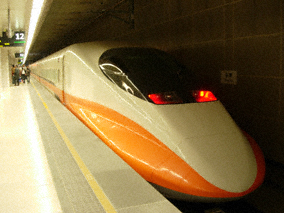
The Taiwan High Speed Rail (HSR) began operating Friday Jan. 5th, 2007. The Taiwan HSR opens a new chapter in the story of high speed rail transportation in Asia, broadening & building upon successes in Japan & Korea.
Moving at top speeds of 300 kmh / 186mph & running the length of western Taiwan, the HSR shortens travel time between Taipei & Kaohsiung to as little as 80 minutes on its non-stop route. This as compared to 50 minutes by air, four hours & forty five minutes by regular train or six hours by car
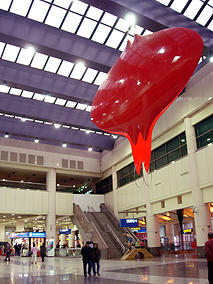
Unlike systems in Europe & other parts of Asia, the organizing philosophy behind the Taiwan’s mass transit network is “the High Speed Rail as longitude and area mass transportation systems as latitude”, where the HSR provides the north-south corridor and the standard Taiwan Railway & local mass transit systems are oriented to criss cross cities. This unique integration has been termed the 3 Irons or, in Chinese, San-Tieh. While the Taiwan HSR is the shortest high speed route in the world, it is being operated as a high-speed north-south national MRT. The HSR intersects with local MRT systems and regular railroad lines at strategic points as it approaches major population centers in its run up and down the island.
Significant Spatial Transformation
A report given by the Department of Urban Planning at Feng Chia University in August, 2005 explored the influence of the transit system on Taiwan’s society & economy. The research 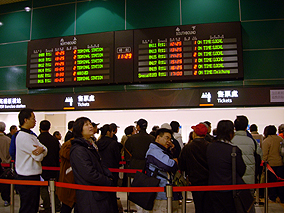 concluded that the introduction of a nationwide railroad in 1908 sparked a spatial re–distribution of population and commerce in Taiwan and forms the basis of the island’s transportation story. According to the report, the introduction of Taiwan’s National Highway No.1, the Jhongshan Freeway, in 1978 and Taiwan’s National Highway No.2, the Formosa Freeway, in 1993 ignited a Significant Spatial Transformation which saw the populations of both Tainan & Taichung rise from 500,000 to 1,000,000. Academics predict a third revolution through the linking of northern, central and southern metropolises via the impact of the Taiwan HSR.
concluded that the introduction of a nationwide railroad in 1908 sparked a spatial re–distribution of population and commerce in Taiwan and forms the basis of the island’s transportation story. According to the report, the introduction of Taiwan’s National Highway No.1, the Jhongshan Freeway, in 1978 and Taiwan’s National Highway No.2, the Formosa Freeway, in 1993 ignited a Significant Spatial Transformation which saw the populations of both Tainan & Taichung rise from 500,000 to 1,000,000. Academics predict a third revolution through the linking of northern, central and southern metropolises via the impact of the Taiwan HSR.
Planning for the HSR has been underway since 1971 and was laid out in the “First Stage Taiwan Area Overall Transportation System Committee“ of the Institute of Transportation at 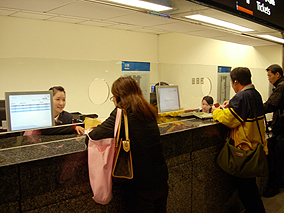 the Ministry Of Transportation & Communications under the ministry’s transportation system scholar Dr. Jiang Yu-Shen, Ph.D., Massachusetts Institute of Technology.
the Ministry Of Transportation & Communications under the ministry’s transportation system scholar Dr. Jiang Yu-Shen, Ph.D., Massachusetts Institute of Technology.
Originally, the plan was to integrate the HSR directly into the existing Taiwan Railway system & stations. Former president Jiang Jing-Guo lobbied the committee to set the HSR's links into local systems at points outside of city centers, suggesting that HSR stations would raise property values for their entire surrounding areas and attract development & population to the regions.
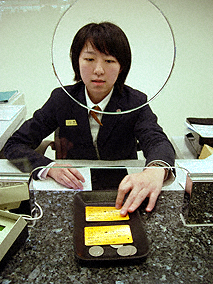
And, indeed, HSR stations have been placed at the periphery of the current city centers for the regions they serve. Under the San-Tieh / 3 Irons system, each locality where the HSR stops is working to build its own MRT systems to integrate the city centers with the HSR. The development of those integrated MRT–HSR stations has been completed at Taipei and Banciao. MRT completion dates for stations further down the line are: Taoyuan 2012, Hisnchu 2010, Taichung 2013, Tainan 2010, & Zuoying-Kaohsiung end of 2007. Additional HSR stations will be opened at Nangang, Miaoli, Changhua and Yunlin by 2010. Among these additional cities only Nangang is also expected to develop an MRT system. Where MRTs have not been completed integrating the cities with HSR stations will be accomplished via existing modes of mass transit.
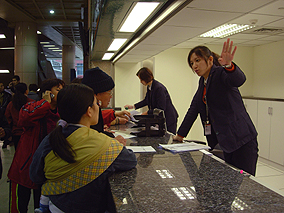
More exciting, with the advent of the HSR and its hyper speeds, Dr. Jiang described the ability to explode the concept of what constitutes a suburban neighborhood. With the full implementation of the HSR it is predicted Taoyuan, Hsinchu, Taichung & perhaps even Chiayi could provide housing alternatives for people employed in Taipei. With travel times so shortened, these regions, formerly at impractical distances, are now related by what HSR planners call “One-day Living Circle” distances. Academics are focusing even keener interest in whether Tainan will become a housing alternative for people working in Kaohsiung.
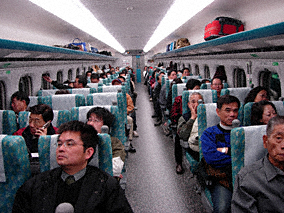
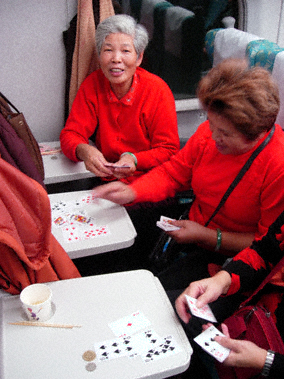
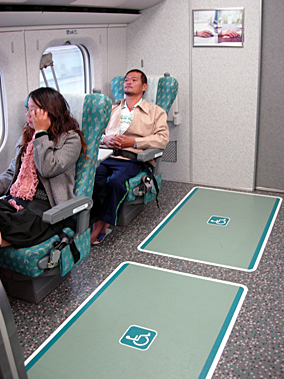
Currently there are 8 HSR stations online – Taipei, Banciao, Taoyuan, Hisnchu, Taichung, Chiayi, Tainan, Zuoying-Kaohsiung. In keeping with the 3 Irons program, the HSR is slated to meet up with local MRTs in each of its respective stations.
HSR trains roll out with twelve cars total. Reaching speeds of 300 kph / 186 mph requires more than just your single front–end locomotive. In the case of the HSR, nine of the train’s twelve cars provide power. This multi–engine system not only raises maximum speeds, but also allows for greater space in the typically “locomotive” cars. Thus, passengers can even find themselves seated in either of the two bullet–shaped ends of the train.
Eleven cars are standard class, providing 923 seats in rows five seats across, 2+3. Each train’s single business class car offers 66 seats in rows four seats across, 2+2.
The HSR system was built by the Taiwan High Speed Rail Corporation, a private corporation under a B.O.T. agreement – Build, Operate, Transfer - with the national government. After 35 years of operation, the system will be returned to the government. The total cost of development so far has been NT$480 billion, or around 14.5 billion US$.
Cars for the HSR are based on a design used by Japan’s Super Express HSR, modified to fit Taiwan’s topography and environment. This unique design is called the Train 700 Taiwan. They are built by in Japan by a 3-company consortium – Kawasaki Heavy Industries, Ltd.; Nippon Sharyo Ltd & Hitachi Ltd.
Cars are soundproofed and every train is equipped with handicapped accessible seats and washrooms. Vending machines are found in the 1st, 5th & 11th cars. Every car displays real-time travel information such as time to next destination and current speed.
Business Class seats in general are 1.6 ~ 2.2 times higher than standard fares and offer:
- Bigger personal space.
- Each seat has a padded foot cushion.
- Personal Music System: five music channels, classic, jazz, light music, Mandarin and Western pop music. Total 5 hours. (Headphones are not provided unless passengers request from the service personnel, but jacks are installed at each seat so you can use you own headphones.)
- Each seat also has a single 110V electrical outlet.
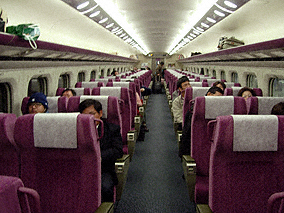
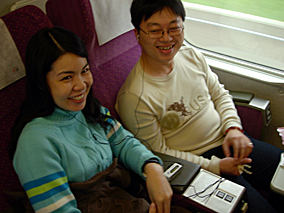
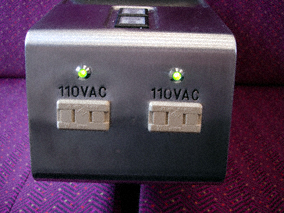
Currently, the HSR has 30 trains and 5 different runs, titled somewhat prosaically…A, B, C, D, E. During the opening period of operation the following routes are online: B, D, E.
- ATaipei to Kaohsiung–Zuoying, end to end, non-stop (80 minutes)
- BTaipei, Banciao, Taichung, Kaohsiung–Zuoying (91 minutes)
- CTaipei, Banciao, Taichung, Changhua, Yunlin, Chiayi, Tainan, Kaohsiung–Zuoying (117 minutes)
- DTaipei, Banciao, Taoyuan, Hsinchu, Miaoli, Taichung, Changhua, Yunlin, Chiayi, Tainan, Kaohsiung–Zuoying, all stations (136 minutes)
- ETaipei, Banciao, Taoyuan, Hsinchu, Miaoli, Taichung (65 minutes)
The length of the HSR route is 345 km / 214 miles. German and French engineers are piloting the HSR trains, training their Taiwanese counterparts.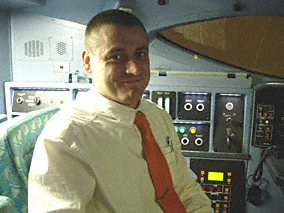
There are 48 tunnels in total. The longest tunnel is the Eight Diagrams through Baguah Mountain, 7.36 km / 4.6 miles excavated by German engineers over 17 months. Throughout the system there are three tunnels longer than 4 km / 2.5 miles.
Average daily ridership during initial years is predicted to reach 145,000. After the trains initial phase is completed, stations will be open 19 hours a day, from 5:30 am to ~ 12:30am. During the initial phase stations will open from 7am to 10:30pm.
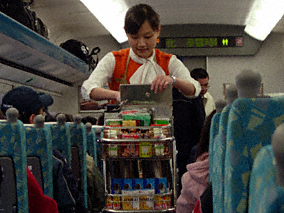

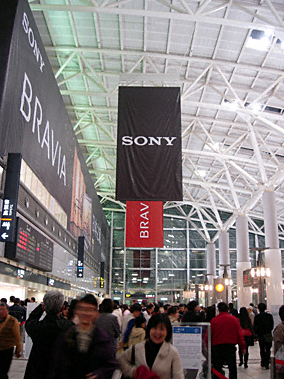
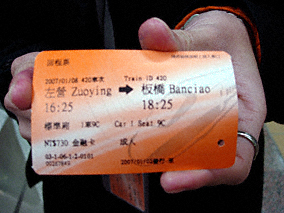
Passengers can reserve seats and purchase tickets at station vending machines or ticket windows. Reservations can also be made over the Internet. Passengers who have made a reservation and paid for tickets can pick up their tickets at a station vending machines or ticket windows before boarding.
| Train type | Taiwan High Speed Rail 700T( HSR 700T) |
| Number of cars | 12 Power: 9 Classes 2: Standard 11 cars, Business 1 car |
| Seating | 989 seats – 923 standard class, 66 in business class |
| Maximum Speed | 300 kmh / 186 mph |
| Seating Layout | 2+2 in business class (4 seats in each row). 2+3 in standard (5 seats in each row) |
| Length |
Total length: 304m / 997.4 ft Width: 3.38m / 11ft Height: 3.65m / 12ft Bullet–shaped End Cars 27m / 88.6 ft Center Cars 25m / 82 ft |
| HSR Construction Fee | NT$480.6 billion US$14.5 billion CA$17.2 billion |
| Route | 345 km / 214 miles: Taipei Station to Kaohsiung–Zuoying Station: Elevated railway: 242 km / 150 miles (73%), Embankment: 40 km / 25 miles |
| Tunnels | 48 tunnels in total The longest tunnels is at Baguah Mountain, 7.36 km / 4.6 miles Three tunnels are longer than 4 km. |
| Passes Through | 14 cities and counties, 77 townships |
| Empty Weight | 503 tons |
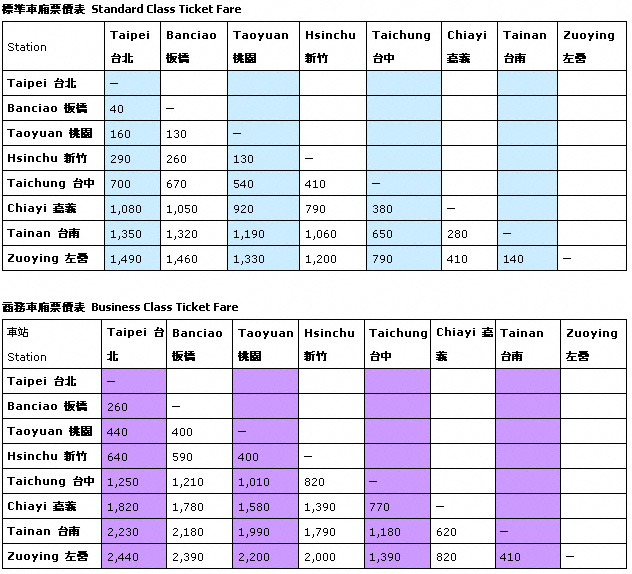

台灣高速鐵路
台灣高速鐵路(簡稱「台灣高鐵」)於西元2007年1月5日開始營運,在亞洲,這是繼日本、南韓之後的交通新頁。
台灣高鐵行車時速最高可達300公里/186哩,大幅地縮短了台北至高雄的交通時程,目前搭乘飛機於兩地往返需五十分鐘,搭火車需四小時四十五分鐘,自行開車需六小時,一旦台灣高鐵的直達車開始營運,從台北到高雄,則僅需八十分鐘。

「以高鐵為經,區域大眾運輸系統為緯」的高速大眾運輸路網,日後將和台鐵、捷運、公車等區域運輸系統,進行橫向整合,而這樣的整合簡稱「三鐵」。雖然,台灣高鐵是現今全世界最短的高速鐵路,但被定位為「高速捷運」的角色,因此,營運方法和歐洲、亞洲大不相同。
Significant Spatial Transformation
以前,往返於台灣南北最快速的方式,都是以搭船居多,兩地的商務活動也因此受限。台灣逢甲大學都市計畫系系主任劉耀華表示於2005年八月的一份研究報告中,深入探討了運輸系統對台灣生活圈結構的影響,一如其他歐美國家,西元1908年鐵路的興建造就台灣第一次空間革命,奠定了交通發展史的基礎;西元1978年通車的中山高速公路(國道1號),以及1993年通車的第二高速公路(國道3號),則是台灣生活區的第二次空間革命。
 台灣高鐵完成後,北中南三大都會區將可整合一巨型都會帶,將會造就台灣地區第三次空間革命,並實現一日生活圈的理想(One-day Living Circle)。
台灣高鐵完成後,北中南三大都會區將可整合一巨型都會帶,將會造就台灣地區第三次空間革命,並實現一日生活圈的理想(One-day Living Circle)。
高鐵的籌備開始於西元1971年,由台灣交通部運輸研究所「第一期台灣地區整體運輸系統計畫委員會」負責規劃,當時該計畫的主持人是台灣著名的運輸系統分析學者 -
姜渝生博士。姜渝生指出,現今的高鐵的站點與原來的計畫有所差異,在原來的計畫中,是將台鐵與高鐵整合在一起,但因為考量整合後的高鐵車站周邊地價勢必飛漲,和當時前總統蔣經國考慮新市鎮的開發,所以才會將高鐵車站自台鐵移開。
而高鐵的車站,確實非座落在縣市繁榮的中心,在三鐵共構的概念下,高鐵的每個站點將會發展出各自的聯外捷運系統,以串聯車站與市中心,目前聯外捷運系統已發展完成的有台北和板橋。高鐵各站點的聯外捷運系統未來將陸續完成的則包含:桃園 (西元2012年)、新竹 (西元2010年)、台中 (西元2013年)、台南 (西元2010年)、左營/高雄 (西元2007年底)。另外,高鐵也計劃於2010年新增南港、苗栗、彰化及雲林四個站點,其中,南港站將規劃捷運系統。由於目前仍有一些聯外系統尚未建設完成,因此暫時以現有的交通系統作為接泊。

姜渝生表示,高鐵的出現,帶動西部大都會人口分佈及就業的重新分配,桃園、新竹、台中將會成為台北的腹地,甚至嘉義都有可能會成為台北的腹地,至於台南是否會成為高雄的腹地,仍有待時間觀察。
現在高鐵共有八個車站在營運:台北、板橋、桃園、新竹、台中、嘉義、台南、左營/高雄。為了達成三鐵共構,高鐵各站點將會整合完整的聯外捷運系統。
高鐵共有十二節車廂,由於最高行車時速可達300公里/186哩,因此其中的九節車廂設計為動力車,此設計讓坐在前後車廂的旅客仍有足夠寬敞的空間,不會感到擁擠。 十一節為標準車廂,共923個座位,每排有5個座椅 (2+3);一節為商務車廂,共66個座位,每排有4個座椅 (2+2)。



台灣高鐵是由民間企業高鐵公司承包,屬於政府公共建設BOT案 (Build, Operate, Transfer)。按現有BOT模式,高鐵公司自承包台灣高鐵該年起計算,35年後,必須將台灣高鐵歸還給台灣政府。高鐵計畫總建設經費共耗資新台幣4,806億元,約美金150億元。
台灣高鐵列車以「日本新幹線」為核心系統藍圖,將其改良設計成符合台灣地形及環境的「列車700 Taiwan」行駛。高鐵列車則是由三家日本公司:Kawasaki Heavy Industries, Ltd.、Nippon Sharyo Ltd.、Hitachi Ltd. 聯合建造。
高鐵列車除了設有隔音設備外,還有販賣機(位於1、5、11車)在車上定點販賣,及每節車廂皆設有為殘障人士設計的特別座椅、專用洗手間,而且都有旅客乘車資訊系統,提供如到達地點、預定到達時間、目前速度等訊息。
在票價上,商務車廂座位約為標準車廂座位的1.6~2.2倍,其特色如下:
- 有較大的個人空間。
- 每個座椅附有腳踏墊、閱讀燈、音樂台。
- 個人音樂收聽系統,共有五個音樂頻道:古典、爵士、新世紀/輕音樂、國語流行音樂、西洋流行音樂讓旅客選擇,提供總長約5小時的音樂。不主動提供耳機,旅客若有需要可向服務員索取,但是,市面上一般的隨身聽耳機亦可相容,可行自攜帶上車使用。
- 每個座位皆提供110V電源插座,皆是兩孔插座。
高鐵營運初期以30組列車,五種行車模式A、B、C、D、E提供服務(請參考下列圖示),初期試營運期間為以B、D、E行車模式為主。
- A台北到高雄左營,直達車,車程約80分鐘。
- B台北、板橋、台中、高雄左營,車程約91分鐘。
- C台北、板橋、台中、彰化、雲林、嘉義、台南、高雄左營,車程約117分鐘。
- D台北、板橋、桃園、新竹、苗栗、台中、彰化、雲林、嘉義、台南、高雄左營,車程共約136分鐘。
- E台北、板橋、桃園、新竹、苗栗、台中,車程約65分鐘。
高鐵路線全長約345公里/214哩,全線共48座隧道,最長的隧道為八卦山(約7.36公里,由德國經17個月開鑿完成),其中超過4公里的隧道有3座。營運初期每日載客量估計約可達14萬5千人。
高鐵於建設完成後,各站將每日營運19小時,自早上5點30分至凌晨12點30分。但於營運初期則為早上7點至晚上10點30分。
至於訂票方式,則開放網路預先訂位,或於各車站的自動售票機或售票窗口進行購票。旅客完成訂位付款後,可於乘車前至車站內之自動售票機或售票窗口取票。







| 車型 | 台灣高鐵700T |
| 列車車廂數 | 共有12節車廂,由9節動力車及3節無動力車構成,其中1節為商務車廂使用,其餘11節為標準車廂 |
| 座位數 | 989席,其中標準車廂923席,商務車廂66席 |
| 最高營運速度 | 300公里/小時 |
| 座椅配置 | 商務車廂:2+2(每排4個座椅) 標準車廂:2+3(每排5個座椅) |
| 列車長度 | 車身長度: 27公尺(兩端車輛) 25公尺(中間車輛) 總長度 304公尺 車身寬度 3.38公尺 車身高度 3.65公尺(至頂板) |
| 高速鐵路計畫總建設經費 | NT$480.6 billion US$14.5 billion CA$17.2 billion |
| 路線 | 全長約345公里(台北站至高雄的左營站),全線工程主要為高架橋樑佔約242公里(佔73%),其餘為隧道約48公里及路堤/路塹約40公里。 |
| 隧道 | 全線一共48個隧道,最長隧道為八卦山(約7.36公里,由德國經17個月開鑿完成)和龜山隧道,其中超過4公里之隧道有3座。 |
| 沿途經過 | 14個縣市、77個市鄉鎮區 |
| 空車重量 | 12節列車車廂約503頓 |
